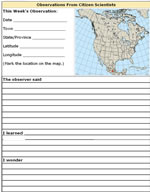What does it look like when monarchs come down to rest in the evening?
Read the first-hand account below from a woman in Marietta, Oklahoma and look for details.
- Notice the many numbers she included in her notes. List all of the things she quantified (measured or counted).
- What do you know because she quantified her observations?
- What surprised you most about this woman's observation?
For Your Journal: Each week, choose your favorite monarch sighting and record your thoughts in your journal. >>
Observation from a Citizen Scientist
September
30: Marietta, Oklahoma (34 N, -97 W)
THEY'RE HERE!!! Woohoo! I was outside from approximately 4:40 until 7:20
p.m. and observed the following numbers:
4:40 - 6:15 p.m.
From 4:40 until approx. 6:15 p.m. I saw them at the rate of about 1 every
5 minutes, which doesn't sound like a lot...but I had not been seeing
any at all, so that was a huge increase. They were flying, slightly higher
than the tree tops, in a south/southwestward direction.
6:15- 6:50 p.m
The numbers picked up sharply around 6:15 p.m. until about 6:50 p.m. From
about 3 to 5 per minute beginning about 6:15 p.m. until about 6:40, and
then 5 to 10 per minute until about 6:50 p.m. They were still slightly
over the tree tops but occasionally dipping down a little lower....but
still not coming down to nectar on the flowers. They were still headed
west/southwest, although perhaps a little more westward than earlier.
6:50-7:10 p.m.
From about 6:50 until about 7:10, the party was on! I stood in our driveway,
with our woodland about 75' to my north and the neighbors' woodland about
60' to my south. The monarchs were coming through at the rate of about
25 per minute from 6:50 to 7:00 p.m. and then at about 50 per minute until
7:10 or so.
7:10 to 7:15 p.m.
Then they tapered off pretty rapidly to about 5 to 10 per minute from
7:10 to 7:15 or so and then 1 to 4 per minute until about 7:20. Then,
that was it. It was over. The last wave, from 6:50 onward, was clearly
seeking a tree to roost in. They flew down into the trees and sort of
flew from tree to tree as they went from our woods to the neighbors' woodsand
I lost sight of them. (There were approximately 300+ monarchs.) I think
some of them stayed in the oaks and pecans on the edge of our woods, but
it was too dark to tell for sure. I'll check those trees at first light
in the morning.
It was an amazing couple of hours, especially as sunset approached. It
was about 82 degrees at 4:30, and there was a
light wind out of the north, about 5-7 m.p.h. By 7 p.m., it probably had
dropped to 73 or 74 degrees and the wind had virtually stopped blowing.
During the very late 1990s and very earliest 2000s, we had hundreds, if
not thousands, roost on a very tall and mature dying elm on the edge of
our woods. They covered the almost bare limbs to the extent that the tree
looked like it had leaves again. It was an exquisitely beautiful sight....and
we have not seen those numbers here in over half a decade.
6:00
a.m. (October 1)
I think mine may have chosen the neighbor's woods, and that area is so
snake-infested, I cannot get near those trees to see if they did. I think
they flew "through" our trees on their way next door. It is
46 degrees on my back porch, as of 6 a.m., so I think I can get out and
check my own trees before the snakes start stirring.
9:30 a.m
Apparently our overnight low temp. (42 degrees) kept the monarchs hanging
in their trees for a few hours this morning until it warmed up. I didn't
see any the first hour or so after sunrise (at 7:25 am), but finally began
seeing some activity....monarchs coming up out of the crowns of the trees
where they'd probably roosted overnight.
9:30 a.m
By 9:30 a.m., they were leaving the trees, nectaring in the pastures (and
our yard and garden!), and flying southwestward. For about a half hour,
I saw them at the astonishing (for me!) rate of 25 to 50 per minute (or
maybe even a little more). At that point it was about 55 degrees, no wind,
endless visability except for low fog banks over parts of the Red River.
They stayed low, nectaring, as they flew towards the southwest. That lasted
20 or 25 minutes, and then it dropped to about 10 to 15 per minute.
11 a.m.
By 11 a.m., the temperature was up to about 60 degrees, still great visability
and no wind. I guess most of the monarchs were flying high by then, because
I was only seing 1 to 5 per minute.
So, a pretty good start to the day. Tonight I plan to be outside from
late afternoon to sunset to see if we have a repeat of last night's numbers.
Can
you find others?
Look for more details about monarchs roosts.
- You can find all observations reported this week in the sightings database and on the migration maps.
